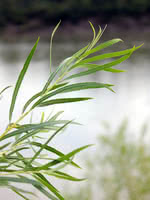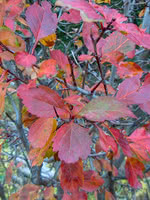Mon-Fri 9am - 5pm Mountain time
Sandbar Willow vs Black Hawthorn
Salix exigua
Crataegus douglasii
CUSTOM GROW
NOT AVAILABLE THIS SEASON - MIGHT RETURN
Sandbar Willow is a deciduous species native to much of North America. This mid-sized, fast-growing shrub can be found in very wet areas, making it an ideal plan to use in a wet area with erosion risk.
Sandbar Willow has long, narrow green leaves, and its grassy narrow stems give it an attractive, bamboo-like appearance.
All willow are important to native pollinators each spring as they have higher amounts of pollen and nectar early each growing season when other food sources are scarce.
Black Hawthorn is a versatile plant that is native to wetlands and other areas with moist soils, but can also tolerate dry soils. This plant can be grown as a short shrub, or a tree reaching 30 feet tall.
Black Hawthorn is valued for erosion control and attracting pollinators. It also makes an attractive flowering ornamental that can be planted as a specimen or pruned as a hedge. It is commonly used in shelterbelts.

